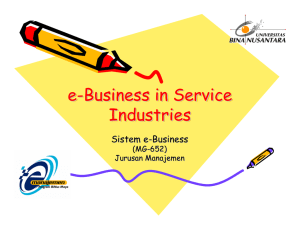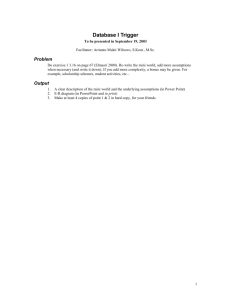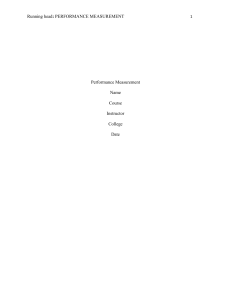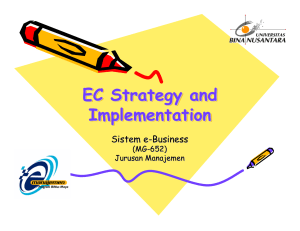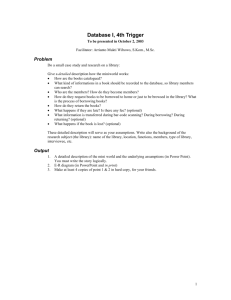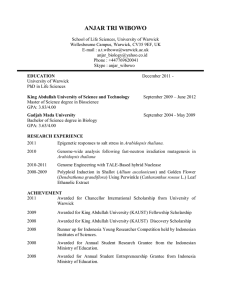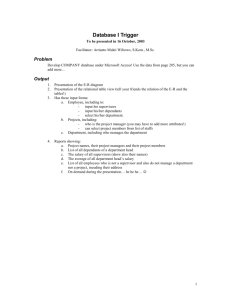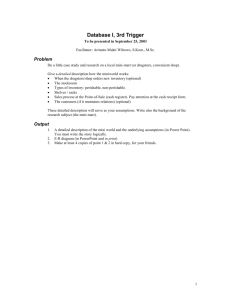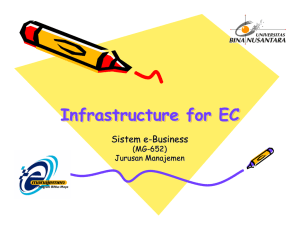Intranets and Customer Asset Management Sistem e
advertisement
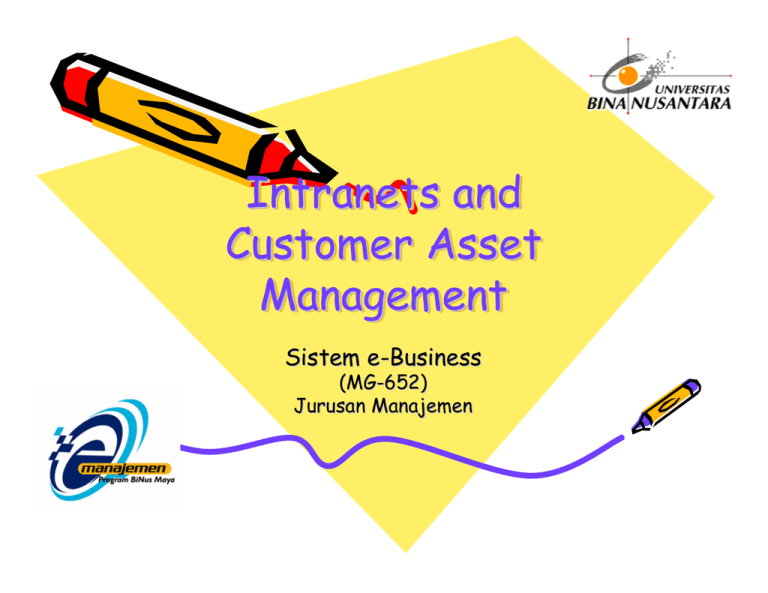
Intranets and Customer Asset Management Sistem e-Business (MG-652) Jurusan Manajemen Agenda • • • • • • • • Why Customer Asset Management? Online Sales Force Automation Online Customer Service and Support Technology and Marketing Strategy Data Mining and Decision Support Intranet-based Decision Support Architecture Marketing Decision Support Applications Summary 05 September 2002 Chandra Wibowo W. 2 Data Mining and Decision Support Intranet-based Decision Support Architecture Marketing Decision Support Systems Technology and Marketing Strategy Order planning, forecasting, fulfillment Customer relationship management Introduction Marketing Decision Support Applications Trend Analysis Channel Management The Web and Customer Service Online Sales Force Automation Customer feedback Cross-selling and Upselling Business Requirements Field Service Management CAM and Supply Chains Customer Asset Management The Role of Technology in Customer Service From Reactive to Proactive Service Challenges in Implementing CAM Online Customer Service Support Functions of Sales Force Automation Elements of Online Sales Automation Intranets and Sales Automation Help Desk Management Informational Needs for Effective Service Accessing Service Information Enabling Intranet Technology Routing and Workflow Management Recording Customer Feedback 05 September 2002 Chandra Wibowo W. 3 Why Customer Asset Management? • CSA is being employed by companies seeking to increase revenue and competitive advantage. • CSA is the integration of the front-line activities in a supply chain (sales, marketing intelligence, and customer service). • CSA is based on the premise that customers are the most valuable asset of any business. • The benefits of managing customers as strategic assets include creating more loyal customers. 05 September 2002 Chandra Wibowo W. 4 Four conditions for managing customers as strategic assets: 1. Current customers are a predictable source of future sales. 2. Customers can be segmented in terms of future sales potential (asset value) based on the history. 3. Customers, like every other asset, are subject to depreciation (now standard accounting practice in the U.S). 4. Customers can be bought and sold (merger and acquisition decisions). 05 September 2002 Chandra Wibowo W. 5 Challenges in Implementing CSA Two major challenges for implementing CSA systems: 1. The information needed to describe, track, and capture the customer as part of an asset base can be difficult or expensive to gather. (Solved by using the Web and Intranets, the cost economics for data acquisition and management). 2. Related to coordination of the company’s information systems and its marketing programs. (Can be overcome by increasing crossfunctional interaction in companies). 05 September 2002 Chandra Wibowo W. 6 CSA and Supply Chains • Why CSA is important in the context of supply-chain management? 05 September 2002 Chandra Wibowo W. 7 Online Sales Force Automation • The sales function is critical for the success of any business, by streamlining the information flow between customers and companies, business are seeking to eliminate sales order mistakes and the resulting rework, increasing productivity. • The result is reduced order fulfillment costs and dramatically shortened delivery cycles. 05 September 2002 Chandra Wibowo W. 8 What is Sales Force Automation? SFA satisfies two basic functions: 1. To support the person in the field. 2. To integrate sales activity into a corporate information structure to improve overall corporate efficiency and coordination with other business-critical functions. 05 September 2002 Chandra Wibowo W. 9 Elements of Online Sales Automation • Sales person productivity tools. • Online telemarketing. • Direct mail and fulfillment. • Sales and marketing management. • Sales force compensation management. • Sales process management. Online sales automation systems can automate the work of a single sales person, a single marketing activity like direct mail. 05 September 2002 Chandra Wibowo W. 10 Intranets and Sales Automation The Intranet-enables sales automation framework has multiple benefits: • It helps bridge “the islands of information” that can exist within a company, especially within sales and marketing. • The availability of interactive Web monitoring software and intelligent agents makes it possible to built a “smart” solution that delivers vital and specific sales intelligence directly to each sales representative. • Intranets can also be used for electronic publishing, to educate and inform sales representatives and make the selling process more proactive by providing all the information and tools necessary to close the sale on-site at a customer location. • Once the Intranet-based solution is in place, companies find it possible to extend information sharing beyond the boundaries of the enterprise, to outside parties critical to the sales effort. • Shorten the sales cycle through pre-qualification of prospects. • Increase revenue through targeted marketing. • Automate the management and qualification of Web leads. • Capture all customer information directly into sales database. • Enhance order management with access to data on pricing, promotions, availability, production schedules, export regulations, carriers, and transportation schedules. 05 September 2002 Chandra Wibowo W. 11 Summarizing the Implementation Challenges Business Problem Timely and low-cost distribution of information. Need to reduce cycle time for filling orders. Solution Use the WWW to publish and solicit content. Automate processes using Intranets and enable electronic sales via the Web. Requirements Interface internal order management systems with the Web. Benefits Low-cost medium with fast turnaround. Enables world wide electronic sales. Automates internal business processes. 05 September 2002 Chandra Wibowo W. 12 Online Customer Service and Support Reasons why online customer service is “HOT” • Lower support costs by empowering customers to solve issues independently. • Provide global access to critical customer service information and forums any time. • Improve service by focusing internal customer support resources on complex issues • Empower business partners with hot links to related online resolution information. • Create proactive service and marketing programs. • Seamless Web/telephony integration for priority responsiveness. 05 September 2002 Chandra Wibowo W. 13 The Web and Customer Service • Many companies have begun to use Web sites and e-mail systems to provide answers to frequently asked questions or to allow customers to access procedures for repairing an item or initiating a service call. Æ More information quickly, interactively, and eventually in realtime. Æ A Web site can be like an ATM of customer service. • Companies will able to use Web sites not just to provide information about products and services, but to show customers new products, gather ideas, and set up a dialog. Æ Use the web’s multimedia capabilities. 05 September 2002 Chandra Wibowo W. 14 Information Systems Challenges Customer Support Business Problem Training support personnel in a fast-changing area like technology is expensive. Need to provide customers better access to customer support information. Solution Internet access to product sheets, frequently asked questions, and other support information. Requirements Interface internal support systems with the WWW. Benefits Expected competitive advantage via up-to-date, information, reduced support overhead. 05 September 2002 Chandra Wibowo W. globally available 15 Help Desk Management Help desks are receiving a growing number off calls. Developing or purchasing Intranet software tools that automate their help desk support functions: • Easy access to customer data. • Asset and inventory tracking. • Problem hand-off and escalation capabilities. • A support knowledge base. • Reporting capabilities. 05 September 2002 Chandra Wibowo W. 16 The enabling Intranet technology Customer Service Representatives (CSRs) need access to timely, relevant, and accurate information that portrays all aspects of the customer-company relationship. The Intranet technology can enhance the CSRs for: • Informational needs for effective service. • Accessing service information. • Routing and workflow management. • Recording customer feedback. 05 September 2002 Chandra Wibowo W. 17 Technology and Marketing Strategy There are new applications of technology in developing marketing strategy: 1. Marketing Decision Support Systems 2. Data Mining and Decision Support 3. Intranet-based Decision Support Architecture 4. Marketing Decision Support Applications 05 September 2002 Chandra Wibowo W. 18 Intranet architecture for marketing decision support Legacy Front End W eb Browser Mobile / Portable Client Presentation and User Interaction Modelling, Clustering, Statistics, profiling, 3-D Visualization M arket Data Transform ation Directories, Data Analysis Techniques, Business Intelligence Data m anagem ent Functions Data Extraction, Validation, Security, Integration, Replication and Sanitation Operational Data and Documents Market Data and Documents Sales Data Consumer Account Data Remote Servers Providing Operational and Historical Information 05 September 2002 Chandra Wibowo W. 19 Marketing Decision Support Systems • Sharper competition and/or Agile competition, means that there is a business imperative for organizations to make decisions quickly. • Product innovations and marketing strategies are rapidly copied, so the ability to respond quickly to a changing market becomes the crucial determinant of both profitability and survival. Æ needs information that is timely, accurate, and relevant, and that contains the right level of detail. 05 September 2002 Chandra Wibowo W. 20 Data Mining and Decision Support • The most successful data mining solutions are tuned to deliver optimum performance for knowledge workers: easy data access and manipulation, enabling them to use data creatively. Æ used the relational databases and online transaction processing (OLTP) systems. 05 September 2002 Chandra Wibowo W. 21 Intranet-based Decision Support Architecture The use of e-commerce technology to improve the gathering, analysis, and distribution of information among the sales, customer, and marketing functions. Æ linking the sales force with regional and corporate offices. Companies need to collect market intelligence quickly and analyze it. The architecture consists of three key components: 1. Storage and loading. 2. Transformation and integration of data. 3. Visualization and presentation of data. 05 September 2002 Chandra Wibowo W. 22 Marketing Decision Support Applications Decision support applications can be divided into the following categories: • Order Planning, Forecasting, and Fulfillment. • Customer Relationship Management. • Trend Analysis. • Channel Management. 05 September 2002 Chandra Wibowo W. 23 Summary • This chapter discussed the Customer Asset Management functions: marketing, sales, and customer service operations, which form the front lines in the supply chain. • Online sales automation systems will result in the changing sales from a science into a thoroughly engineered business process. Æbroken into logical steps and can be reflected in its automation systems. • The role of customer service operations has changed greatly, so the customer service function has grown more competitive and complex, and so has the information technology needed to support it. • Electronic commerce technology, in particular data mining, can have a significant role in marketing strategy. 05 September 2002 Chandra Wibowo W. 24
